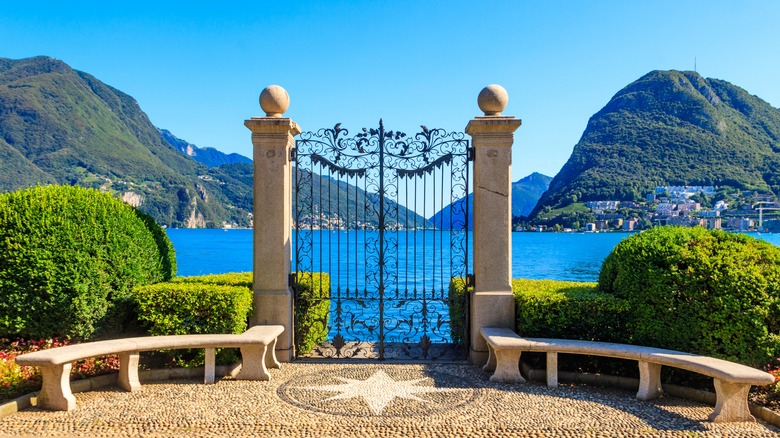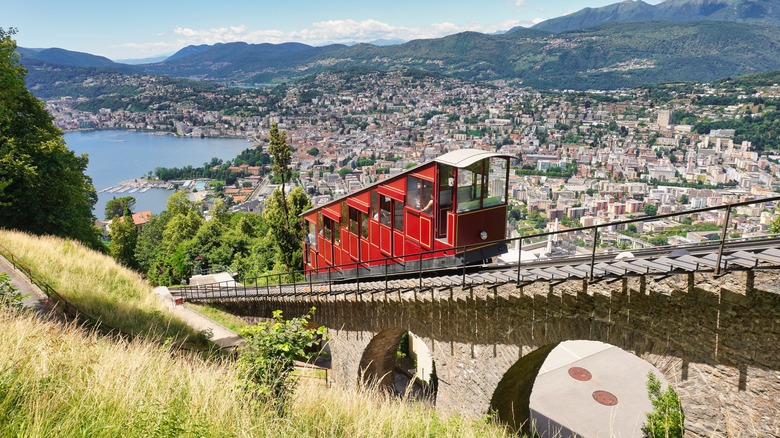Switzerland's Sunniest Region Is An Underrated Beauty Known As The Country's 'Little Italy'
When you think of Switzerland, you might think of swishing down the slopes at an Alpine resort before tucking into fondue in a wood-paneled ski chalet, or taking a bracing hike like the one that made Rick Steves fall in love with hiking. What you might not think of is sun-drenched olive groves and practicing your Italian to order an aperitivo.
Allow us to introduce Ticino, Switzerland's Italian region and its sunniest — it gets more than 2,170 hours of sunlight annually. Known as the "Little Italy" of the country, Ticino boasts a sub-tropical Mediterranean climate with sultry summers and mild winters, perfect for growing olives and grapes, and yes, even palm trees. The capital city of this southernmost region (canton) is Bellinzona, full of historic sites. Lugano, on the shores of Lake Lugano, is another popular town for tourists, who love the galleries and museums, such as the renowned Museo d'arte della Svizzera Italiana, and the stately promenades that are just begging to be the stage for a romantic evening stroll.
Also situated on Lake Lugano is the municipality of Morcote. The village has been deemed so beautiful it warranted a spot on the Swiss Federal Inventory of Heritage Sites (ISOS) which is made up of places the government has earmarked as meriting protection. The parks and palaces, winding alleys, and historic architecture are a lovely window into the heart of Ticino.
What to do in Ticino
Swiss wine is not widely exported, so you may not have had the chance to sample a Pinot Noir Blauburgunder or nice dry Edelweiss unless you've traveled to Switzerland before. Merlot, including the novel white merlot, is the name of the vineyard game in Ticino. The semi tropical climate lends itself to winemaking, so be sure to have a glass of a local varietal. You can take a guided bike tour of the Mendrisio area wineries, which seems like the ideal way to sample some new favorites.
Sharing a border with Italy means cuisine in the canton has absorbed the flavor of its neighbor. Rather than the hearty potato rostis and melted cheese raclette decadence popular on Alpine Swiss tables, in this southerly realm, you're more likely to encounter pasta and dishes with a Mediterranean flair. Michelin has found the food worthy, awarding two stars each at Restaurant Ecco Ascona and La Brezza, both in the town of Ascona.
If you can tear yourself away from your plate, you may want to spend time exploring some of the historic sites. In Bellinzona, the UNESCO World Heritage Site of Fortezza Bellinzona is a top rated attraction. The castle of Castelgrande overlooks the outlying valley, with a wall and second castle (Montebello) forming fortifications. A third castle (Sasso Corbaro) is part of the UNESCO site, but sits separately from the other two.
Getting around in Ticino
Ticino is gorgeous and certainly worthy of a leisurely extended visit, but as a fairly small area, many visitors include it as part of a larger European holiday. Getting there depends on where you are coming from. Some tourists make it a day trip from Lake Como or add it on to their tour of other lesser-known Italian lakes. The closest major airports are in Milan and Zurich.
Swiss Travel Systems (SBB) is the national transportation network and operates with the precision of a Rolex (which is also Swiss). Consider whether a Swiss Travel Pass will fit your needs, particularly if you are planning a longer trip to other parts of Switzerland. The pass is only available to tourists and covers rail, gondolas, boats, and buses in the network. It also covers your admission at more than 500 attractions, over 40 of them in Ticino. Ask at your hotel about the Ticino Pass, which entitles overnight guests to free public transit and discounts at select tourist activities throughout the canton.


